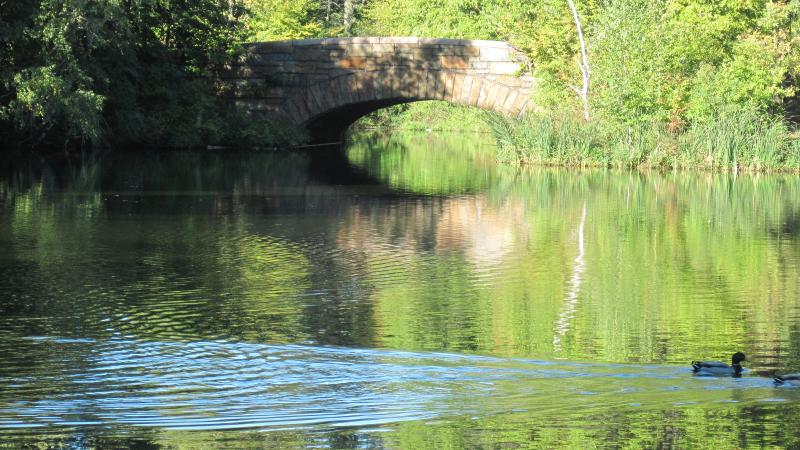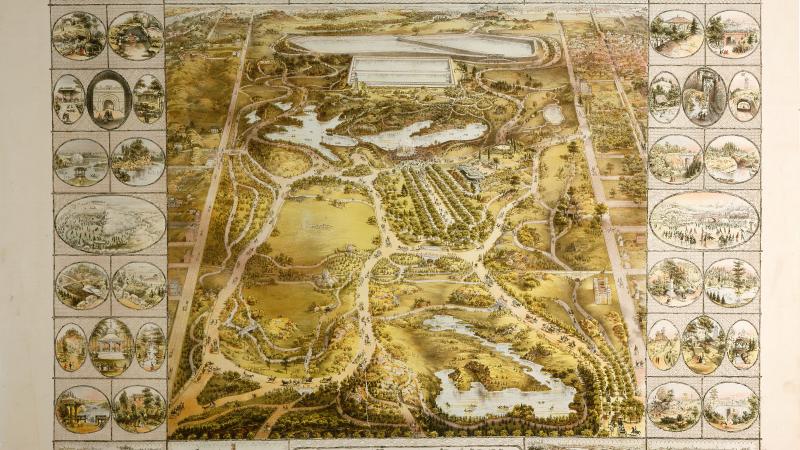It is impossible to envision what our designed landscapes would look like if Frederick Law Olmsted Sr. had not needed a job in 1857. Born in Hartford in 1822, with Connecticut roots that stretched back to 1636, the father of American landscape architecture was, in modern parlance, slow to launch. First, he tried surveying and then a stint as a clerk for a firm that imported silk. Bored, Olmsted signed on at twenty-one as a hand on the China-bound Ronaldson. One grueling journey proved to be enough. The young man then dallied at Yale, hanging around his more diligent brother, John, and his college friends.
The next venture bankrolled by his merchant father was scientific farming, first at Sachem’s Head in Connecticut and then on Staten Island. To prepare himself, Olmsted enthusiastically apprenticed himself to George Geddes, who had been commended by the New York State Agricultural Society for his farm practices. From spring to harvest in 1846, Olmsted stayed at Fairmount, Geddes’s farm in the Finger Lakes, learning the technical skills to start a fruit and vegetable business.
But soon the restless Olmsted was lobbying his father for permission to go on a walking trip in England with John and their friend Charles Loring Brace. The son rationalized to the father that he would learn useful farming techniques in the English countryside. And learn he did, but not about farming.
The trip yielded Walks and Talks of an American Farmer in England, which was dedicated to Geddes and published in 1852 by George Putnam, Frederick Law Olmsted’s Staten Island neighbor. That same year, Henry Raymond, at the instigation of Brace, hired Olmsted to be the unbiased eyes of the New-York Daily Times in the South.
By 1855, Olmsted seemed settled into a literary career. With $5,000 borrowed from his father, Olmsted had become a partner in Dix, Edwards & Company, the new owners of Putnam’s Monthly Magazine. But, like many magazines, Putnam’s sent its publishers straight into bankruptcy.
Two years later in the summer of 1857, Olmsted had no magazine, little money, and no job, just as joblessness spread across the country as a result of the economic panic. Charles Elliott, a friend who sat on the commission charged with coming up with a large park for New York City, suggested that Olmsted apply to become superintendent of Central Park.
No less a personage than Washington Irving backed Olmsted’s successful application for what was essentially a chief of grounds job. The main objective was to clear brush and smash stone, and do so for a park that only existed as a poorly conceived design by Egbert Viele, the civil engineer who was now Olmsted’s boss.
In the meantime, the architect Calvert Vaux, who had worked with tastemaker extraordinaire Andrew Jackson Downing, went around insisting that New York needed a better vision for its park. The park board ordered a design competition, and Vaux approached Olmsted, asking him to partner with him for the contest. Vaux brought design and drawing skills; Olmsted brought an understanding of the topography of a rocky, swampy site that the city managed to get only because it was unsuitable for real estate development.
As Olmsted put it, “It would have been difficult to find another body of land . . . upon the island (unless by taking a long narrow strip upon the precipitous side of a ridge), which possessed less of . . . the most desirable characteristics of a park.” Lacking a natural “genius of place”—that ineffable quality that makes a landscape unique or even magical—Central Park would have to be given one.
Biographer Justin Martin sees in Olmsted’s early experiences a fortuitous apprenticeship for designing Central Park. As a small boy, Olmsted had ridden with his father on horseback, taking “loitering journeys” in the Connecticut countryside. Before he was even ten, he read English landscape theorists William Gilpin and Uvedale Price. Then he became a farmer, if ever so briefly, but like these other experiences it helped him become especially observant about land.
Borrowing from England
Walks and Talks—a pleasurable read for anyone who has ever wandered the English countryside, especially the Midlands that inspired Tolkien’s Shire—has all the wide-eyed quality of an American in England for the first time: Oh, the church spire! Ah, homely cottages! Ooh, blooming hawthorn! Aah, pubs with quaint names! He even marvels at the sight of a “real (unimported) Hereford cow over the hedge,” though he had surely seen a cow before. But tucked into the breathless prose is naturalist poetry. His observation, for instance, of “mild sun beaming through the watery atmosphere, and all so quiet” captures how achingly beautiful the softly lit English countryside is.
This emotional affinity for the pastoral shaped Olmsted’s vision for Central Park and many future works. But it was memories from a chance visit to Birkenhead Park, the first publicly funded park in Britain, that helped define for him the purpose of a park.
Birkenhead was still new. Located near Liverpool, it had been designed in the 1840s by Joseph Paxton. Olmsted was immediately struck by its beauty and social significance. After only a few minutes, “I was ready to admit that in democratic America there was nothing to be thought of as comparable with this People’s Garden,” he wrote in Walks and Talks. “And all this magnificent pleasure-ground is entirely, unreservedly, and for ever the people’s own. The poorest British peasant is as free to enjoy it in all its parts as the British queen. More than that, the baker of Birkenhead has the pride of an OWNER in it.”
The reform-minded Olmsted was convinced that parks could improve the living conditions and lives of city dwellers. And they would be good for America as a whole. Olmsted “intended his parks to be public institutions of recreation and popular education that would demonstrate the viability of the republican experiment in America,” wrote Charles Beveridge, editor of the Olmsted Papers Project.
In an 1858 letter to the Board of Commissioners, Olmsted made it plain that he believed parks might replenish the spirits of all who came to them. “It is one great purpose of the Park to supply the hundreds of thousands of tired workers, who have no opportunity to spend their summers in the country, a specimen of God’s handiwork that shall be to them, inexpensively, what a month or two in the White Mountains or the Adirondacks is, at great cost, to those in easier circumstances.”
To a friend, Olmsted made an even bolder claim. Central Park, he said, was “a democratic development of the highest significance & on which, in my opinion, much of the progress of art & esthetic culture in this country is dependent.”
The design submitted by Olmsted and Vaux in 1858 borrowed heavily from Paxton’s emphasis on the notion of a greensward: swoops of meadows and clusters of trees and scenic vegetation near water, all artfully arranged to convey the loveliness of the English countryside.
To create uninterrupted vistas, Olmsted and Vaux proposed in their now iconic Greensward Plan that crosstown roads be built in trenches eight feet deep, an idea uniquely their own. When this proposal was challenged, Olmsted waged a public relations campaign in the press. His friend, newspaperman Richard Grant White, wrote in the plan’s defense, “It is not only so beautiful in its grand outlines and its details, but so complete, symmetrical, and consistent with itself, that it can hardly be changed in any essential point.”
Bridges over the trenches allowed unimpeded passage for park visitors, and separate pathways for pedestrians, riders, and carriages permitted park users to safely enjoy the park at their own pace without interference from others.
In the Parade Ground, now called the Sheep Meadow, and the Ramble, the spot Olmsted considered his best work in the park, we still get hints of some of the landscape ideals he held dear. Earlier English design theorists who influenced Olmsted put landscapes into three categories: the beautiful, the picturesque, and the sublime. The beautiful is a gentle landscape that feels cozy and domestic—in a word, safe. The picturesque is wilder and denser than the pastoral, but can still be created by human hands. The sublime, however, is the work of water, wind, and geologic time; these are the ones, awesome and even dangerous, that humans cannot copy. In visual terms, it is the difference between a Connecticut painting by John Henry Twachtman and a Yosemite painting by Albert Bierstadt.
The military Parade Ground, a required design element in the contest that Olmsted acceded to, was to be, in the Greensward Plan, beautiful: “a broad open plane of well-kept grass.” It was turned over to sheep in 1864, a move the designers favored.
Today, thousands of New Yorkers still enjoy the pastorally inspired open space. The Ramble, Olmsted’s “wild garden,” was and remains picturesque in landscape design terms. A lush, wooded site, the Ramble was the most botanically complex part of the park because Olmsted, a master at mixing foliage, was constantly fiddling.
To give Central Park its genius of place took 250,000 tons of gunpowder, thousands of trees, tons of grass seed, and the movement of, by Olmsted’s estimate, “10 million one-horse cart loads” of earth. At the height of construction in 1859, more than 3,800 men worked the site. And, like most public projects, it had huge cost overruns, which put Olmsted at odds with Andrew H. Green, the comptroller with the unenviable task of reining in the park’s chief architect.
The park was beloved by New Yorkers from the get-go. An estimated ten thousand New Yorkers descended on Central Park the second Sunday it was open in December 1858, many of them participating in the new rage—ice-skating. The New York Herald reported that “all ages, sexes and conditions of life, from the ragged urchin with one broken skate to the millionaire” mingled on the lake. The following summer, the commission approved free concerts, the beginning of the park’s history as an arts venue.
Still, with all this success, Olmsted had not yet fully committed himself to life as a landscape architect. To be fair, the field still wasn’t defined. During the early years of the Civil War, he ran the U.S. Sanitary Commission, a relief agency for soldiers, and then he went west to run a gold-mining venture in the hope that he’d earn enough to care for his growing family. (He had married Mary, the widow of his brother John, in 1859. Instantly, he became the father of three children under the age of seven.) In California, he also headed a commission to protect Yosemite and designed Mountain View Cemetery in Oakland.
Beyond Central Park
When Olmsted returned East, there were two attractive options: work on The Nation, which he had cofounded, or join Vaux in the creation of Prospect Park in Brooklyn. Olmsted set his course for the next three decades by choosing Prospect Park. Olmsted, Vaux & Company finished their plan for the Brooklyn park in January 1866. Although the site required engineering, its overall shape was better than the Manhattan park’s, making the creation of paths easier. More importantly, the head of Brooklyn’s commission was fully behind them.
In their proposal, Olmsted and Vaux planned for an even bigger artificial lake than Central Park’s and “a broad stretch of slightly undulating meadow without defined edges, itself lost in a maze of shadows of scattered trees.” The Long Meadow, with all its pastoral charms, drew countless croquet players. For many landscape architects and designers, it epitomizes Olmsted’s design vision.
Acclaim for the two New York parks brought in requests from around the country, including from Chicago, for a privately funded speculative venture to turn Riverside into a model suburb with all the benefits of a park. The partners eventually pulled out of the venture, partly because they were not receiving payment. But their plans made good roads, common spaces, and leafy parkways de rigueur. “Any modern suburb—if it’s well thought out—likely owes a debt to Olmsted and Vaux’s 1868 plan” for Riverside, says Justin Martin.
In Buffalo in 1868, Olmsted and Vaux designed the nation’s very first park system, where three distinctly different green spaces were linked with the latest design concept of Olmsted’s—the parkway. This “influential innovation” could “provide a continuous pleasure ground that kept the character of neighborhoods near it residential,” says Beveridge. Ten years later, Olmsted (long since separated from Vaux) began work on Boston’s Emerald Necklace, a series of parks stretching over seven miles that is the largest park system he ever made. It includes Franklin Park, Harvard’s Arnold Arboretum, and my personal favorite, the Back Bay Fens, where I dawdled as an undergraduate.
Today, the Fens draws all sorts of urbanites, but between the Victory Gardens and the Rose Garden, it is not quite what Olmsted had in mind. When Boston’s city fathers called in the landscape architect, they had already held a design competition and found nothing that would solve the problem of a seemingly unpromising site.
Olmsted, once again recognizing the genius of place, took land that had been a sewage dump for Boston’s Back Bay, and working with the city’s engineers on a complicated scheme to manage water, turned the space into a salt marsh, an appropriate move for land in a tidal estuary. Damming of Boston’s Charles River in the early 1900s changed water flows in ways that could not sustain plants used to brackish or salty water, but Olmsted’s creative solution represents possibly the first ecological restoration project done in America.
Olmsted restored land on a much grander scale with the last landscape project he did before he retired in 1895. This time he applied his philosophy to a private, rural landscape. George Washington Vanderbilt II hired Olmsted, who was working on other Vanderbilt properties, to do the grounds for Biltmore, the grand estate he was building in Asheville, North Carolina.
Biltmore’s curving approach road and the surrounding forests are a testament to what happens when there’s a budget sufficient for the vision. In a bold move, Olmsted convinced Vanderbilt that his estate did not need a country-style park so much as a forest to fill in a landscape that had been denuded by farming. Gifford Pinchot, the future head of the U.S. Forest Service, was brought in to run the nation’s first experiment in managed forestry.
Olmsted called Biltmore “a private work of a very rare public interest.” And one day, the public would indeed benefit from it. After Vanderbilt’s death, more than 80,000 acres of his forest were sold to the government and became part of the Pisgah National Forest.
The number and importance of Frederick Law Olmsted Sr.’s firsts are awe-inspiring. Collectively, the Olmstedian body of work—from the earliest designs with Calvert Vaux to the later ones by his stepson John and his namesake, Frederick Jr.—number more than six thousand commissions, half of which got off the drawing board. With design credits for city parks, urban greenways, and leafy suburbs across the United States and Canada, Olmsted’s great gift is inescapable. He taught us that beautiful parks are a public good, and that they give cities souls worth having.




